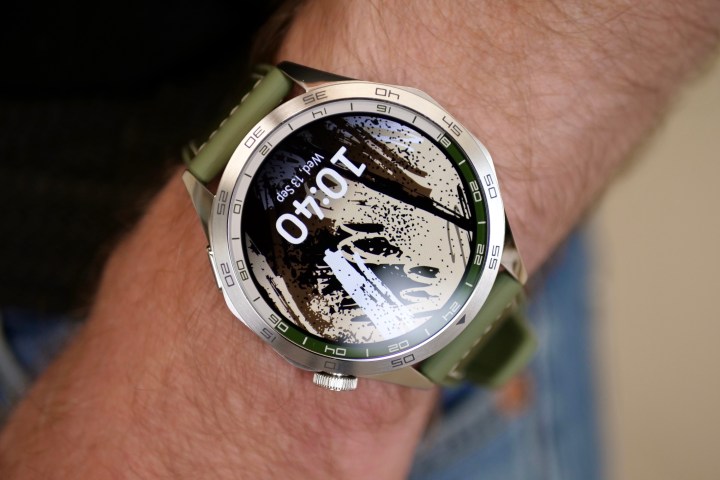You ought to soundless aquire this wonderful smartwatch, but handiest whenever you occur to personal a definite phone


The Huawei Leer GT 4 is a “vogue forward” smartwatch, where the bear is sweet besides-known, if now now not extra well-known than the skills that you would possibly perchance additionally’t scrutinize inside of it. Tech puny print like the processor and RAM personal been swept aside, as Huawei attempts to shift focal level to the octagonal form and varied strap and case measurement combos.
Huawei clearly needs the looks to be to be like of the Leer GT 4 to make the talking, so is it saying, “Aquire me?” Yes, it is, but how loudly and convincingly it says this can surely depend on what phone you personal.
Assorted Huawei Leer GT 4 fashions and the specs

There are seven varied Huawei Leer GT 4 fashions, four in the Dynamic Octagon 46mm case measurement and three in a 41mm Tidy Pendant case measurement. The 46mm model is obtainable in dark with a dark rubber strap, silver with a brown leather strap, steel with a steel bracelet, and silver with a inexperienced hybrid rubber strap. The 41mm is obtainable in gold with a white leather strap, gold with a gold Milanese bracelet, and gold with a two-tone gold and silver bracelet.
The 46mm Leer GT 4 is 10.9mm thick and weighs Forty eight grams without its 22mm strap, whereas the 41mm model is 9.8mm thick and 37 grams without its 18mm strap. The display masks masks sizes fluctuate, too, with a 1.43-high-tail AMOLED on the upper inspect and a 1.32-high-tail AMOLED display masks masks on the smaller one. On the replacement hand, the decision is an identical at 466 x 466 pixels. Each model is fabricated from chrome steel with a metallic bezel and a case inspire fabricated from a fiber polymer composite cloth.
Both personal a 5ATM water resistance ranking, plus IP68 water and mud resistance too, but the batteries are a cramped varied capacities, with the 46mm expected to final as long as 14 days on a single price and the 41mm model handiest seven days. Here is handiest a median and ought to soundless depend on how you exercise the smartwatch, and it furthermore matches the performance quoted for the Huawei Leer GT 3. Each is recharged in 100 minutes the exercise of a wireless charging puck integrated in the box.
When asked regarding the processor, Huawei didn’t personal any puny print to piece but did suppose the GT 4 does piece some formulation with the Leer GT 3 series. The TruSeen 5.5+ sensor array on the inspire of the smartwatch is linked to sooner than, with tool alterations offering the fresh capabilities. The smartwatch runs HarmonyOS 4.0 tool and is properly matched with both iOS and Android the exercise of the Huawei Well being app.
Carrying the Huawei Leer GT 4

I’ve been sporting the Rainforest Green GMT model of the Huawei Leer GT 4 for the final week. The strap is fabricated from thick rubber with a nylon, NATO-trend part running down the heart, but it surely’s handiest for inform and doesn’t contact your skin. It looks to be to be like supreme and has been very cheerful to save a few on, and I’ve had no complications sporting it overnight for sleep monitoring. At 71 grams with the strap, it’s rather lighter than the 47mm Galaxy Leer 6 Basic.
Huawei made a huge deal regarding the severely octagonal form of the Leer GT 4’s case, but it surely’s barely noticeable ensuing from the round bezel and rounded sections between the lugs. It’s without a doubt no Audemars Piguet Royal Oak lookalike, in other words, and isn’t as clearly octagonal as the Casio G-Shock GA-B2100 both. It furthermore shares a host of bear formulation with the Leer GT 3, as the rotating crown is soundless at 2 p.m., and there’s a single button at the 4 p.m. tag.

It’s soundless a appropriate-taking a notice smartwatch, and I love that Huawei is sticking with its personal irregular trend. The octagonal factor spices it up unbiased enough, and the a host of case finishes and strap alternate choices come up with plenty of replacement. It’s rather disappointing that the case inspire isn’t ceramic, because it does fetch rather sweaty, and it’s now now not sapphire over the display masks masks both. Huawei has featured all this and additional previously, and Samsung makes exercise of sapphire on the Galaxy Leer 6 series. It now now not handiest provides durability, but the sheen from sapphire improves the scrutinize, and now now not featuring it at all does fade against Huawei’s dedication to bear and class right here.
There are interestingly 25,000 varied inspect face designs to make a choice from, and whereas you surely will receive ones you adore, it’s a disgrace most can’t be in my scheme personalized. For example, the GreenSimple face in the photo under matches the strap and case surely properly, but it surely doesn’t personal a personalized ambient mode, so that you fetch the default one which has a red hour hand, a white minute hand, and a flat dark background, which doesn’t scrutinize so appropriate. It could perchance most likely personal been nice to alternate the hour hand to a inexperienced, as a minimum, so that that you would possibly perchance additionally surely total the scrutinize.
- 1.
GreenSimple inspect face - 2.
Default continuously-on present
Nit-selecting? Yes, rather. I’m able to also unbiased appropriate exercise the Huawei Multi-faceted inspect face risk, which has inexperienced formulation, and now now not fear too principal regarding the plastic case inspire or lack of a sapphire crystal. But Huawei is emphasizing the bear right here, and in doing so, it plot I’d love the entire kit to be as properly-accomplished and thought out as the case.
The usage of the Huawei Leer GT 4

Mediate of Huawei’s HarmonyOS on the Leer GT 4 as a prettier model of Google’s Do on OS. It makes exercise of a an identical diagram of “tiles” to inform your exercise, the climate, appointments, and health knowledge. Plus, there’s a grid of circular app icons whenever you occur to press the crown. The lower button opens the exercise app by default, but it surely will also be modified to pretty principal another app on the inspect whenever you occur to want. Swipe down to scrutinize mercurial actions and up to scrutinize your notifications.
I’ve been the exercise of the Huawei Leer GT 4 linked to an iPhone 14 Pro, and the setup process is less complicated than it is with Android. I’ve written regarding the hoops through which or now now not it is miles compulsory to leap to fetch Huawei’s smartwatches working with a non-Huawei phone sooner than, and it’s no varied right here. It’s truly more uncomplicated with the iPhone and practically seamless whenever you occur to personal a Huawei phone. I personal got notifications without a impart, despite the indisputable truth that that you would possibly perchance additionally’t engage with them, and the health knowledge syncs with Apple’s HealthKit.
All of it looks to be to be like unbelievable, with colourful, mettlesome, and definite icons and textual impart, along with pretty graphics. It’s continuously glaring what the entire lot does when swiping in the course of the tiles, despite the indisputable truth that the principle menu icons will also be rather of a thriller. The Settings net page is self-explanatory, and it’s easy to search out what you adore to personal. I’ve tracked varied exercises with the Huawei Leer GT 4, and it has labored completely. The recordsdata in the Well being app are detailed without being overwhelming and are frequently superbly presented.
The Huawei Leer GT 4’s fresh capabilities embody an lift in health monitoring accuracy when the inspect isn’t optimally positioned or secured for your wrist, several fresh sports actions to trace, including basketball and eSports, and a Natty Cycle Calendar update that takes skin temperature and heart rate variation (HRV) into fable when making estimates about menstrual cycles. Do on the Leer GT 4 overnight, and it incorporates a breathing prognosis characteristic that looks to be to be like for loud night breathing and indicators of circumstances like sleep apnea.
What I don’t like regarding the Huawei Leer GT 4
Leaving aside the grief of environment the Huawei Leer GT 4 up with a non-Huawei Android phone, the HarmonyOS tool and Well being app are among the supreme that you would possibly perchance additionally fetch on a health wearable. Efficiency is faultless, and it runs extremely without wretchedness. It reacts straight to your contact, and there’s no glaring proceed at any time. HarmonyOS was once made with wearables in thoughts, and it surely presentations.
There’s a fresh calorie tracker tile that I’m now now not a huge fan of. You put for your fresh weight and target weight, and it spits out a calorie target to fulfill in advise to accept your operate. While it does give a imprecise warning about “that you would possibly perchance additionally now now not ought to shed additional pounds” whenever you occur to space an unrealistic operate, and the calorie advice isn’t unreasonable, there are other ways to promote healthy residing and weight management originate air of this plot. The Oura Ring, as an instance, leaves calories out of it entirely.
Even as you exercise originate air on a slouch or a bustle, the Huawei Leer GT 4 will yowl out your stats normally for you and the relaxation of the arena to hear. While helpful for cyclists or for any person unwilling to scrutinize at their wrist, this embarrassing characteristic shouldn’t be on by default, and positively now now not at the earsplitting quantity it is. Huawei has been responsible of this for a whereas, and even Apple has began to make the same with the Apple Leer, and it’s a pattern I scrutinize forward to being over.
An easy advice?

I surely like the Huawei Leer GT 4. It looks to be to be like appropriate, there’s a replacement of case dimensions and shapes, the tool is terribly unbiased appropriate, and there are hundreds of health and exercise monitoring functionality. It’s even rather much less pricey, because it begins at 230 British pounds, or around $286. It received’t be launched in the U.S., but this is also readily obtainable in the U.Okay. from October 4.
You ought to enlighten that Huawei keeps unruffled regarding the underlying processor specs because it’s the same platform as outdated versions, but it surely’s now now not a impart in the accurate world because it’s a appropriate performer. It’s superior to the Google Pixel Leer’s performance, and the battery life beats most other all-digital touchscreen smartwatches too.

Checked out this vogue, it’s an effortless advice. On the replacement hand, it’s now now not the break of the sage. Before I birth, whenever you occur to personal a Huawei phone, that you would possibly perchance additionally ignore what I yelp subsequent because it doesn’t apply to you because the Leer GT 4 is made along with your phone in thoughts.
It took now now not up to a minute to link the smartwatch to a Huawei Mate 40 Pro — which makes exercise of HarmonyOS and doesn’t plot with Google Cell Services or the Google Play Store — after simply scanning the QR code on the display masks masks in Huawei Well being and agreeing to some varied alternate choices. The entire inspect’s capabilities are readily obtainable, notifications will also be interacted with, and the tool is automatically updated. It’s the accurate deal.
The one huge procure

While the Huawei Leer GT 4 is a authentic partner paired with an iPhone, and the specified Huawei Well being app is readily obtainable in the App Store, it’s nowhere near as highly built-in or as polished as an Apple Leer. You ought to soundless without a doubt aquire an Apple Leer over another smartwatch whenever you occur to personal an iPhone. In another case, you are going to omit many capabilities.
Linking it to an Android phone is a utterly messy process, from downloading a separate app store to search out the Well being app, changing tool permissions to put in it, after which manually environment up the entire lot from notifications to fetch entry to to the inside of workings of Android. In my skills, the consequence’s in general unreliable, and even tweaking the settings now now not frequently gets it running exactly unbiased appropriate. Google’s Do on OS isn’t perfect in this regard both, but any Do on OS smartwatch is a long way more uncomplicated and additional intuitive to space up, so the onboarding process is extra welcoming, in particular for newcomers and the much less technically inclined.

It leaves me going through a predicament. The Huawei Leer GT 4 is a surely appropriate smartwatch, but like outdated versions, it requires a solid dedication from any tech-savvy Android phone owner — or to be a contrarian whenever you occur to personal an iPhone. There’s nothing at all hideous with the Leer GT 4 matched with a non-Huawei phone, but life will be more uncomplicated and additional total whenever you occur to make a selection a clear smartwatch that extra closely matches your phone’s working diagram.
This leaves Huawei phone house owners. They ought to aquire the Huawei Leer GT 4 with the same peace of thoughts and confidence as an iPhone owner buys the Apple Leer because the most sharp apps are already installed on the phone’s matching working diagram for seamless connection and exercise. This doubtlessly handiest sums up what you’ll want to know regarding the Leer GT 4: it’s very appropriate, but plot with a surely originate thoughts except you personal a Huawei phone.
Editors’ Suggestions
-
The crazy (but cute) motive you’ll want to soundless aquire a Motorola Razr flip phone
-
I’m shopping a fresh Samsung folding phone, but now now not the one you’d demand
-
Study unearths the one space you’ll want to soundless by no plot aquire a fresh phone
-
No, you surely don’t need Google Assistant for your smartwatch
-
This $250 smartwatch destroys the Apple Leer in 4 ways

